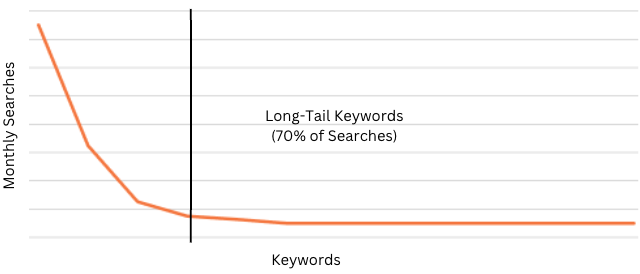What are Long-Tail keywords and How to Use Them

Keyword selection and usage is a fundamental aspect of Search Engine Optimisation (SEO). Knowing how to choose and use the right keywords means you can attract the right audience and gain customers whatever your business. Long-tail keywords are crucial for on-page SEO; they enable a more nuanced and targeted approach to your content. Let’s take a look at the role long tail keywords play in boosting your website visibility and traffic.
What are long-tail keywords?
Long tail keywords—as opposed to short tail keywords—are search terms made up of at least three words. This means they’re much more specific and nuanced and cater to a more informed or more targeted audience. Long tail keywords have a deeper level of detail to them; they help users find precisely what they’re searching for. As a result, the traffic reaching your website is of higher quality and more likely to result in conversions.
Long tail keywords are less competitive and have lower search volumes. Their name comes from the shape of a distribution graph. For SEO, a distribution graph would illustrate how often particular keywords are searched for online. There are typically higher amounts of searches for main keywords and the more specific, nuanced keywords trail off onto the right of the graph to create a long tail. Their lower search volume, however, doesn’t make them less important—especially when you consider that they make up the bulk of searches when you add different long-tail keyword search volumes together.

What’s the difference between long-tail and short-tail keywords?
As mentioned, long tail keywords are search terms consisting of three or more words. By comparison, a short tail keyword will be made up of 1 or 2 words.
For a business in the IT industry, an example of a short tail keyword would be “cloud computing.” Conversely, “best cloud computing solutions for small businesses” would be a long tail keyword. Here, the short tail keyword would be a broad entry point. It’s used by people who are earlier in the buying cycle.
“Cloud computing” would capture a wider audience too: those who are generally interested in the overarching concept of cloud computing. An IT company would find it much more challenging to rank in the top positions of search engine results pages (SERPs) for this term due to high competition and the established authority of existing businesses.
To cater to a more qualified audience, the long tail keyword “best cloud computing solutions for small businesses” would ensure that the content, services and marketing strategies align with the small businesses they’re looking to serve. By using the long tail keyword, the IT business is making sure its content reaches the very people looking for tailored cloud services. The lower competition of the keyword also means the business can establish its authority and gain visibility.
Why are long-tail keywords important for SEO?
Ultimately, long tail keywords attract a more qualified and more educated audience. Their lower competition for ranking in SERPs means businesses can rank more easily. By targeting a careful selection of long tail keywords, businesses can increase the quality of the traffic to their site. Statistics show that more than 70% of searches are for long tail keywords so finding and targeting the right ones can make a huge difference to business.
How to find long tail keywords
There are many tools that businesses can use to find appropriate long tail keywords. These include Google Keyword Planner, SEM Rush and Ahrefs. Businesses can also explore variations of appropriate short tail keywords to find unique opportunities to target a specific audience. Here are some specifics on how to find long tail keywords on each tool:
Google Keyword Planner
In your Google Ads account, you need to find the Keyword Planner tool. When you enter seed keywords (short tail keywords related to your industry), you’ll get a list of suggestions for long tail keywords. These will appear with statistics related to the average number of monthly searches as well as competition metrics. You can use these to gauge how competitive and popular the search terms are.
SEMrush
Like Google Keyword Planner, SEMrush will provide a list of related keywords when you enter specific short tail keywords or your domain. You’ll see their competitiveness as well as search volume. You can also see which keywords your competitors are using to help identify missed opportunities.
Ahrefs
Ahrefs has a keyword explorer tool that allows you to filter keywords to narrow down to specific long-tail variations. You can also look at the difficulty score, which means you get a deeper understanding of each keyword’s competition.
How to target long-tail keywords
The process of targeting long tail keywords is all about creating comprehensive content. This can be through resource pages or blog posts that offer visitors real value by addressing their needs and answering their queries. When you use long-form content to target long tail keywords, your site becomes more relevant in the eye of search engine algorithms and your authority becomes better established.
Final thoughts on long tail keywords
Long tail keywords are a powerful business tool that enable you to attract a more qualified audience. They’re a great way to enhance your marketing strategy and tailor your content to match the intentions and needs of your target audience with precision. Besides attracting a more educated audience, long tail keywords give you a competitive advantage, meaning you can establish authority in specific niches to gain visibility and rise in rankings. Research, here, is crucial. With the long tail keywords established, you’ll need to position them well in your content to make the most out of what they can bring.
